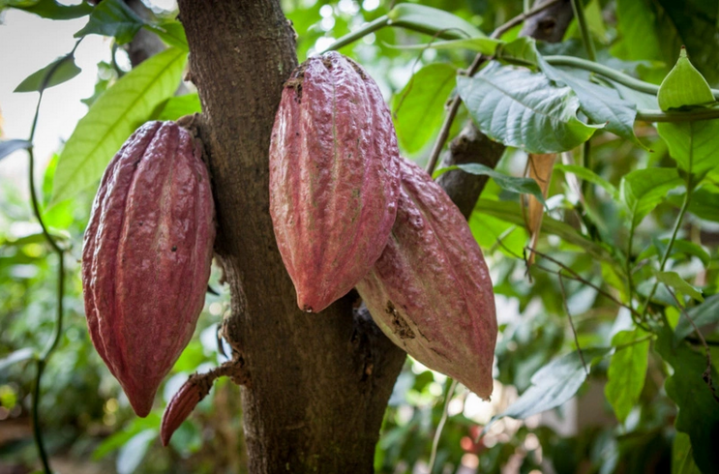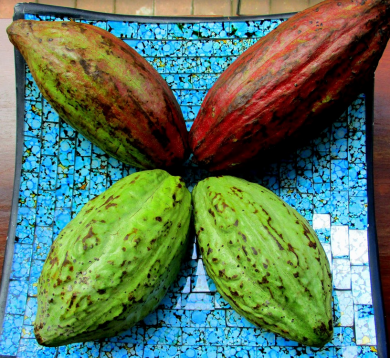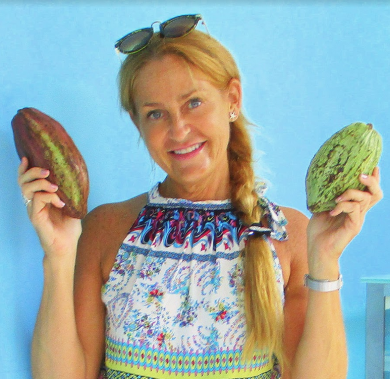
Cacao: an exotic elixir of life
Cacao, Theobroma cacao, is a tropical tree of the Sterculiaceae family but we all know it as yes folks, you guessed it, chocolate! This wonder o
Abundance, strength and godlike qualities, this is what the cacao bean represented to these civilisations. Using the bean in religious rituals, the God responsible for bringing the cacao bean to man was honoured, Quetzalcoatl, as was the Mayan Patron Saint of cacao, Chak
In the 17th century, King Louis XIII married the Spanish Princess Anne, this brought the cacao elixir to the French courts. When in 1650 there was an inundation of drinking possibilities in England due to the arrival of tea from China and coffee from the Middle East, the cacao drink entered the English palate also. The 1 st chocolate confection maker opened in Paris in 1659 and the Italians won prizes for their skills at chocolate creations in 1720. It wasn’t until 1765 North America learned about the cacao drink and over the next 100 years the cacao bean also became cacao powder, dark chocolate bars, milk chocolate and chocolate imbued with nuts. Pharmaceutical qualities were also explored which is not surprising knowing that in the beginning it was known for its restorative, strengthening and aphrodisiac effects.

To obtain the cacao, the harvested pods are fermented by naturally occurring bacteria and yeasts to eliminate the bitter and astringent quality. The seeds are then cured, roasted and the skin is taken off leaving, what is called, the nibs. It is the nibs that create the various products, the fat
Smaller amounts come from Nigeria, Brazil and Cameroon. About 20 pods come from one plant in one year and it takes 10 pods to make 1kg of cacao paste! There are 3 types of cacao pods, one being very precious, Criollo (the Mayan cacao) 10%, and Forastero which accounts for 80% of the chocolate and cacao we see today. The 3 rd cacao pod is a hybrid of the two called Trinitario, the remaining 10%.
There are many health benefits that can come from the consumption of pure raw cacao, this is why if you’re after the positive effects of chocolate rather than just indulgences, you are best to choose dark chocolate with a minimum of 70% cacao plus making sure by reading the label, usually on health food store chocolate bars labels only, the production of the bar you are eating comes from cacao that hasn’t been overheated while processing. In good quality
The result of polyphenols can be reduced inflammation, improved circulation and lowered blood pressure. Flavanol- rich cacao can improve the level of nitric oxide in one’s blood which relaxes and dilates arteries and blood vessels. Cacao has also been found to have a blood thinning effect similar to aspirin. We are all familiar with the mood elevation chocolate can bring, this is due to the flavanols, one of which is tryptophan and this is changed to a mood stabiliser in the body called serotonin. There is also a small amount of caffeine in cacao.

I am still circling the SE Asian areas around our wondrous Thailand settling in Bali for a bit as I have found a lovely villa in which to paint my watercolours. In this article is my version of the Cacao flower, they are normally quite small but I blew them up large so one can see what they look like and I feel mine have taken on some of the effects of the raw cacao ceremonies I have been going to as of late! I call it Cacao Flower Fantasy! Ceremonial raw cacao circles take place here in my little town of Ubud almost daily although the new or full moon is the best time to take part in these circles.
The idea is to hold up a small cup of cacao elixir to the sky and say what you want to release in your life and take a sip, then say what you want in your life and take a sip. Then everyone finishes what they have and dance to some nice tunes. Whether these ideas are fact or fantasy, the cacao plant has given us magic in one form or another through many decades. Most everyone has their favourite way to have chocolate; dark, milk, hot cacao or plain raw cacao powder blended up in a nice smoothie. I love to mix cacao powder with coconut cream in a small blender with chai spices!
Theobroma cacao can be found in Thailand, it was imported from Malaysia just over 100 years ago. Just last year during the 2018 Academy of Chocolate Awards, Thai cacao was among the awardees. Lemuel Dark Chocolate Bars are made from Thai cacao and the bars received a bronze star. The beans used in its award-winning chocolate come from Kad Kakao farm in Chiang Mai, which plans to launch its own chocolate brand and cafe in Bangkok later this year. We can look forward to our own Thai chocolate delights, from bean to bar, experiences soon!

Miss Margaret is enjoying travelling around SE Asia lugging around a suitcase full of watercolour supplies and a laptop, learning about the various medicinal plants surrounding our country of Thailand and



